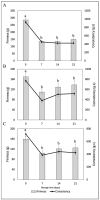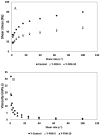Development of Fucoxanthin-Enriched Yogurt Using Nanoliposomal Carriers: A Strategy for Functional Dairy Products with Antioxidant and Erythroprotective Benefits
- PMID: 40333899
- PMCID: PMC12029523
- DOI: 10.3390/molecules30081854
Development of Fucoxanthin-Enriched Yogurt Using Nanoliposomal Carriers: A Strategy for Functional Dairy Products with Antioxidant and Erythroprotective Benefits
Abstract
In pursuing functional foods that promote health, nanoliposomal carriers have been used to enhance the stability and functionality of dairy products such as yogurt, promising therapeutic benefits. This study aimed to evaluate the impact of fucoxanthin-loaded nanoliposomes in yogurt on its antioxidant, physicochemical, and rheological properties under cold storage (21 days). Fucoxanthin-loaded nanoliposomes were prepared using the ultrasonic film dispersion technique and added at concentrations of 0%, 5%, and 10% in the yogurt (Y-C, Y-FXN-5, Y-FXN-10). Homogeneous and uniform nanoliposomes (98.28 nm) were obtained, preserving their integrity and functionality and ensuring the prolonged release and bioavailability of fucoxanthin. Y-FXN-10 maintained the highest antioxidant activity according to the DPPH (52.96%), ABTS (97.97%), and FRAP (3.16 mmol ET/g) methods. This formulation exhibited enhanced erythroprotective potential, inhibiting hemolysis, photohemolysis, and heat-induced hemolysis. However, viscosity and firmness decreased, affecting the texture and appearance. Sensory properties such as the color, flavor, aftertaste, texture, and overall acceptance improved with the 10% fucoxanthin-enriched yogurt formulation. These results suggest that nanoliposomes are suitable for carrying fucoxanthin. Their incorporation into food matrices is critical to developing functional foods. Regulatory approvals and consumer perceptions regarding nanotechnology-based products must be addressed, emphasizing their safety and health benefits.
Keywords: enriched yogurt formulation; fucoxanthin-loaded nanoliposomes; functional foods.
Conflict of interest statement
The authors declare that there are no conflicts of interest.
Figures












Similar articles
-
Evaluation of Physicochemical and Antioxidant Properties of Yogurt Enriched by Olive Leaf Phenolics within Nanoliposomes.J Agric Food Chem. 2018 Sep 5;66(35):9231-9240. doi: 10.1021/acs.jafc.8b02759. Epub 2018 Aug 24. J Agric Food Chem. 2018. PMID: 30110548
-
Encapsulated fucoxanthin improves the structure and functional properties of fermented yogurt during cold storage.Food Chem. 2023 Sep 1;419:136076. doi: 10.1016/j.foodchem.2023.136076. Epub 2023 Mar 29. Food Chem. 2023. PMID: 37004366
-
Characteristics of probiotic yoghurts supplemented with Pu-erh tea infusion.Acta Sci Pol Technol Aliment. 2019 Apr-Jun;18(2):153-161. doi: 10.17306/J.AFS.0640. Acta Sci Pol Technol Aliment. 2019. PMID: 31256543
-
A Review of Processing Techniques and Rheological Properties of Yogurts.J Texture Stud. 2025 Feb;56(1):e70006. doi: 10.1111/jtxs.70006. J Texture Stud. 2025. PMID: 39909732 Free PMC article. Review.
-
Invited review: Advances in yogurt development-Microbiological safety, quality, functionality, sensory evaluation, and consumer perceptions across different dairy and plant-based alternative sources.J Dairy Sci. 2025 Jan;108(1):33-58. doi: 10.3168/jds.2024-25322. Epub 2024 Oct 5. J Dairy Sci. 2025. PMID: 39369892 Review.
Cited by
-
Innovative Controlled-Release Systems for Fucoxanthin: Research Progress and Applications.Pharmaceutics. 2025 Jul 8;17(7):889. doi: 10.3390/pharmaceutics17070889. Pharmaceutics. 2025. PMID: 40733098 Free PMC article. Review.
References
-
- Rashwan A.K., Osman A.I., Chen W. Natural Nutraceuticals for Enhancing Yogurt Properties: A Review. Environ. Chem. Lett. 2023;21:1907–1931. doi: 10.1007/s10311-023-01588-0. - DOI
-
- Almutairi B., Turner M.S., Fletcher M.T., Sultanbawa Y. The Impact of Commercial Prebiotics on the Growth, Survival and Nisin Production by Lactococcus lactis 537 in Milk. LWT. 2021;137:110356. doi: 10.1016/j.lwt.2020.110356. - DOI
-
- González-Vega R.I., Robles-García M.Á., Mendoza-Urizabel L.Y., Cárdenas-Enríquez K.N., Ruiz-Cruz S., Gutiérrez-Lomelí M., Iturralde-García R.D., Avila-Novoa M.G., Villalpando-Vargas F.V., Del-Toro-Sánchez C.L. Impact of the ABO and RhD Blood Groups on the Evaluation of the Erythroprotective Potential of Fucoxanthin, β-Carotene, Gallic Acid, Quercetin and Ascorbic Acid as Therapeutic Agents against Oxidative Stress. Antioxidants. 2023;12:2092. doi: 10.3390/antiox12122092. - DOI - PMC - PubMed
MeSH terms
Substances
LinkOut - more resources
Full Text Sources
Medical
Miscellaneous

